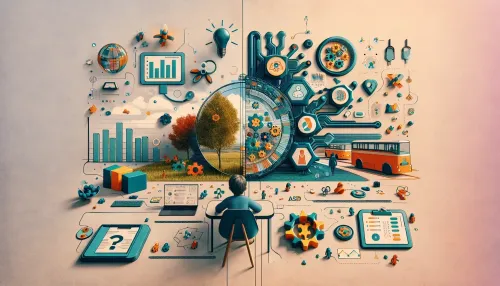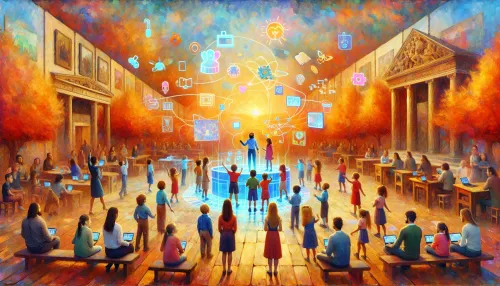Embracing the Digital Age: Innovative Technologies Shaping Autism Education

The evolution of technology has opened new horizons for educational strategies, especially for those tailored to special needs such as autism. Parents, educators, and therapists are constantly seeking more effective ways to engage and educate autistic children, and the digital age is proving to be a rich ground for innovation.
Virtual Reality (VR) is revolutionizing the learning environment for autistic children by providing immersive experiences tailored to their comfort and needs. VR classrooms simulate real-world scenarios in controlled settings, allowing students to practice social cues, routines, and academic concepts without the anxieties associated with crowded or unfamiliar environments.
How Virtual Reality Classrooms Enhance Learning
Artificial intelligence (AI) and machine learning bring a personalized touch to education, adapting to an individual's learning pace and style. For autistic children, this technology can offer custom-built lessons that advance with student progress. By analyzing response times, accuracy, and attention patterns, AI platforms promote a tailored educational journey. This cutting-edge approach resonates well with HorizonsMind Blog readers seeking advanced strategies for their children's development.
Augmented reality (AR) enhances the way autistic children interact with the world by overlaying digital information onto real environments. It's a powerful tool for teaching communication and social skills. AR apps help visualize emotions on virtual characters, aiding children in understanding and expressing feelings. Such innovative resources are highly marketable to our HorizonsMind Blog community, whose interests lie in state-of-the-art tools that encourage development.
Personalized Learning with AI and Machine Learning
Gamification uses game design elements in non-game contexts to enhance motivation and engagement. In the field of autism therapy, games transform repetitive exercises into fun activities. Engaging autistic children through gamified therapy can improve motor skills, cognition, and social interaction.
Augmented Reality Tools for Communication Skills
Digital tools go beyond learning; they also facilitate monitoring a child’s progress in real time. Mobile apps now feature dashboards that display data such as a child's task completion rates, behavioral patterns, and milestones achieved. This tracking empowers parents to make informed decisions about their child's education plan.
The Role of Gamification in Autism Therapy
The expansion of e-learning offers self-paced modules that cater to diverse learning styles a boon for autistic learners who might need more time or alternative methods to grasp concepts. Video tutorials, interactive diagrams, and voice-guided instructions can all be found in modern e-learning modules catering to the autism spectrum.
Tele-education or distance learning mitigates many challenges autistic children face in traditional schooling environments. From the comfort of their homes, students can connect with specialized educators via video conferencing tools. This format not only provides safety and convenience but also opens pathways to educators who specialize in autism.
Related Article: Adaptive Technologies in Autism Care: Innovations from Urban Centers
Real-Time Progress Tracking for Parents
Wearable technology has begun playing an instrumental role in supporting autistic children by monitoring their physiological signs of stress or lack of focus. Devices such as smartwatches can signal alerts when stress levels rise or attention wanes, allowing for prompt intervention. On tech-savvy platforms like HorizonsMind Blog, articles about wearable tech's potential applications provide valuable insights for those invested in cutting-edge autism support strategies.
E-Learning: Self-Paced Modules for Autistic Learners
Finally, adaptive software embodies personalization by evolving with the child’s developmental stages. These platforms adjust material based on mastery level, ensuring challenging yet achievable tasks that foster growth essentially growing with the child over time.
In an ever-progressing digital world, educational technologies are granting new opportunities for children on the autism spectrum making education more accessible, engaging, and effective than ever before. From VR classrooms to adaptive software that evolves alongside students’ abilities, these digital tools embody the potential within cutting-edge technology to not just accommodate but celebrate different ways of learning and being.
Frequently Asked Questions
Virtual reality classrooms provide immersive learning experiences tailored to autistic children's needs. They simulate real-world scenarios in controlled settings, allowing students to practice social cues and routines without anxiety. This innovative approach enhances engagement and comfort, making learning more effective for children on the autism spectrum.
Artificial intelligence personalizes education by adapting lessons to each child's learning pace and style. It analyzes responses and attention patterns to create custom-built educational content that evolves with the student. This tailored approach promotes a more effective learning journey for autistic children, catering specifically to their unique needs.
Gamification enhances autism therapy by incorporating game design elements into therapeutic activities. This approach transforms repetitive exercises into engaging games, motivating autistic children to participate actively. By making therapy fun, gamification can improve motor skills, cognition, and social interaction, ultimately supporting their overall development.
Check Out These Related Articles

Connected Caregiving: Maximizing Support and Resources through Digital Platforms

Virtual Reality and Autism: Transformative Tools for Enhanced Therapeutic Interventions

Tech-Driven Innovations in Autism Assessment and Early Intervention: Adapting to Digital Frontiers
